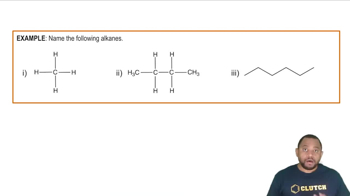Here are the essential concepts you must grasp in order to answer the question correctly.
Alkanes
Alkanes are a class of hydrocarbons characterized by single bonds between carbon atoms, following the general formula CnH2n+2. They are saturated compounds, meaning they contain the maximum number of hydrogen atoms possible for a given number of carbon atoms. Alkanes are typically nonpolar and exhibit low reactivity, making them stable and commonly found in natural gas and petroleum.
Recommended video:
Nomenclature of Alkanes
The nomenclature of alkanes follows specific rules set by the International Union of Pure and Applied Chemistry (IUPAC). The names are derived from the number of carbon atoms in the longest continuous chain, with prefixes such as 'meth-' for one carbon, 'eth-' for two, and so on. The suffix '-ane' indicates that the compound is an alkane, helping to systematically identify and name these hydrocarbons.
Recommended video:
Isomerism in Alkanes
Isomerism refers to the existence of compounds with the same molecular formula but different structural arrangements. In alkanes, this can lead to structural isomers, where the carbon skeleton varies, and positional isomers, where the branching occurs at different locations. Understanding isomerism is crucial for naming and distinguishing between different alkane structures, as they can have distinct physical and chemical properties.
Recommended video:
 Verified step by step guidance
Verified step by step guidance


